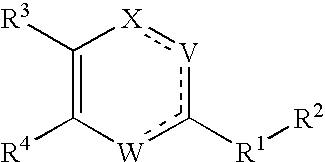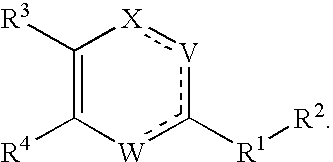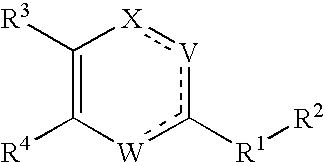Substituted heterocyclic compounds and methods of use
a heterocyclic compound and substitute technology, applied in the field of substitution heterocyclic compounds and methods of use, can solve the problems of small blood vessel adherence and significant neutrophil accumulation in capillaries
- Summary
- Abstract
- Description
- Claims
- Application Information
AI Technical Summary
Benefits of technology
Problems solved by technology
Method used
Image
Examples
example 1
[0175]
5-(4-Chloro-phenyl)-2-[2-(R)-isopropylamino-methyl)-pyrrolidin-1-yl]-3-methyl-6-pyridin-4-yl-3H-pyrimidin-4-one
[0176]Step A: 2-((R)-Isopropylamino-methyl)-pyrrolidine-1-carboxylic acid tert-butyl ester
[0177]To a solution of 2-(R)-Aminomethyl-pyrrolidine-1-carboxylic acid tert-butyl ester 7.72 g in chloroform was added acetone 22.40 g followed by sodium triacetoxyboron hydride 24.54 g. The reaction mixture was heated to 70° C. for 3.5 hours and cooled down to room temperature. Work up to give desired product as light yellow oil. MS (ES+): 243 (M+H)+.
[0178]Step B: (R)-Isopropyl-pyrrolidin-2-ylmethyl-amine
[0179]To a solution of 2-((R)-Isopropylamino-methyl)-pyrrolidine-1-carboxylic acid tert-butyl ester 9.12 g in methanol was added excessive of HCl in dioxane. The solvent was removed after 30 minutes under reduced pressure to give the desired product as off-white solid. MS (ES+): 143 (M+H)+.
[0180]Step C: 5-(4-Chloro-phenyl)-2-[2-(R)-isopropylamino-methyl)-pyrrolidin-1-yl]-3-methy...
example 2
[0182]
5-(4-Chloro-phenyl)-2-[2-(S)-isopropylamino-methyl)-pyrrolidin-1-yl]-3-methyl-6-pyridin-4-yl-3H-pyrimidin-4-one
[0183]The title compound was analogously synthesized by the method described in Example 1 from 2-(S)-Aminomethyl-pyrrolidine-1-carboxylic acid tert-butyl ester. This compound was obtained as yellow solid. MS (ES+): 438 (M+H)+; (ES−): 436 (M−H)−.
example 3
[0184]
5-(3-Bromo-phenyl)-2-chloro-3-methyl-6-pyridin-4-yl-3H-pyrimidin-4-one
[0185]Step A: To a 500 mL round bottom flask (RBF), was added ethyl (3-bromo-phenyl)acetate (10.3 g, 42.2 mmol), 4-cyanopyridine (4.4 g, 42.2 mmol) and 56 mL DMF. The mixture was stirred at room temperature under nitrogen. 42 mL 1 M KOtBu in tBuOH was added drop wise, and stirred for 1 h at rt. Methyl isothiocyanate (3.08 g, 42.2 mmol) was added in one portion, and stirred for another one hour at rt. The mixture was cooled down to 0° C., iodomethane (2.7 mL, 42.2 mmol) was added drop wise and stirred for 1 h at 0° C. To quench the reaction, 100 mL H2O was added. Yellow solid was precipitated. After filtration and washed with H2O, the 5-(3-bromo-phenyl)-3-methyl-2-methylsulfanyl-6-pyridin-4-yl-3H-pyrimidin-4-one was obtained in 9.2 g as pale yellow powder. MS (ES+): 388 (M+H)+; (ES−): 386 (M−H).
[0186]Step B: To a 250 mL RBF, was added 5-(3-bromo-phenyl)-3-methyl-2-methylsulfanyl-6-pyridin-4-yl-3H-pyrimidin-4-...
PUM
| Property | Measurement | Unit |
|---|---|---|
| temperature | aaaaa | aaaaa |
| temperature | aaaaa | aaaaa |
| temperature | aaaaa | aaaaa |
Abstract
Description
Claims
Application Information
 Login to View More
Login to View More - R&D
- Intellectual Property
- Life Sciences
- Materials
- Tech Scout
- Unparalleled Data Quality
- Higher Quality Content
- 60% Fewer Hallucinations
Browse by: Latest US Patents, China's latest patents, Technical Efficacy Thesaurus, Application Domain, Technology Topic, Popular Technical Reports.
© 2025 PatSnap. All rights reserved.Legal|Privacy policy|Modern Slavery Act Transparency Statement|Sitemap|About US| Contact US: help@patsnap.com



